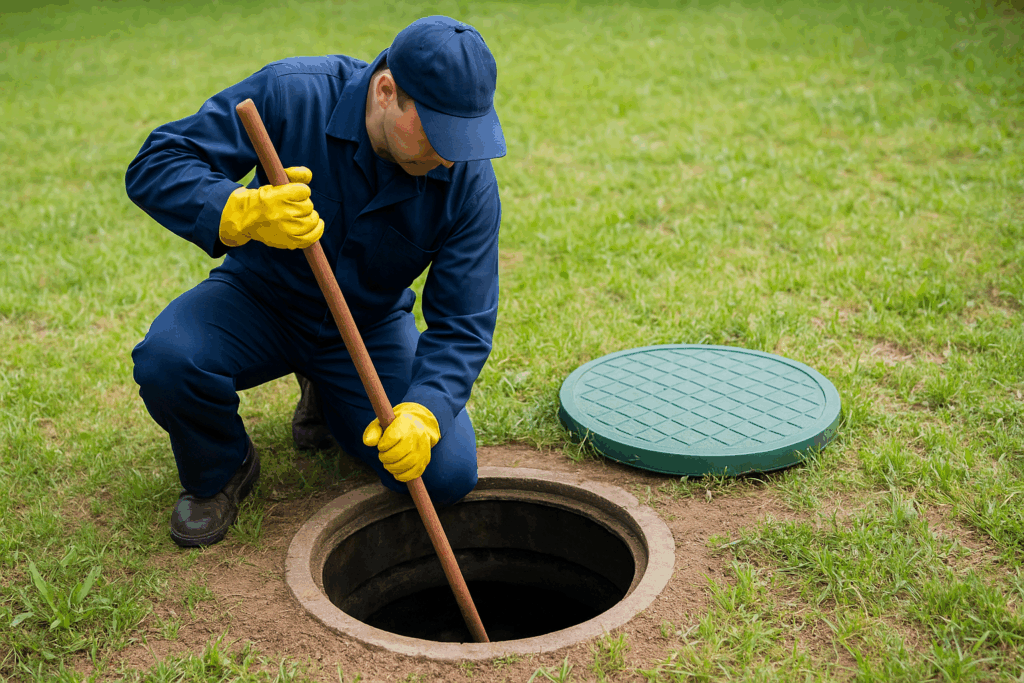A well-maintained septic system keeps your home clean and odor-free. Regular septic tank cleaning prevents costly repairs, backups, and unpleasant smells.
In this guide, you’ll learn 10 expert-approved tricks to keep your septic tank running efficiently and extend its life.
1. Schedule Regular Septic Tank Cleaning
Routine septic tank cleaning is the foundation of an efficient system. Most tanks need cleaning every 2–3 years depending on household size and usage.
Why It Matters:
- Prevents clogs and overflow
- Improves tank lifespan
- Keeps drain field healthy
Quick Tip: Mark your calendar for regular maintenance checks and inspections.

2. Avoid Harsh Chemicals
Using bleach or strong drain cleaners can disrupt the bacterial balance that breaks down waste in your septic tank.
Do Not Use:
- Chlorine bleach
- Antibacterial soaps
- Chemical drain openers
Use Instead:
- Enzyme-based cleaners
- Baking soda and vinegar for natural cleaning
✅ This keeps your septic tank’s bacteria active and efficient.
3. Conserve Water to Reduce Tank Load
Excessive water inflow can overload your system, causing premature septic tank cleaning needs.
Ways to Conserve Water:
- Install low-flow toilets and showerheads
- Fix leaky faucets
- Spread laundry loads throughout the week
| Household Type | Ideal Cleaning Interval | Water Use Level |
|---|---|---|
| 2–3 members | Every 3 years | Low |
| 4–5 members | Every 2 years | Medium |
| 6+ members | Every 1–1.5 years | High |
4. Pump Out Sludge on Time
Sludge buildup is inevitable — but neglecting it leads to overflow or backups.
How to Know It’s Time:
- Slow draining sinks or toilets
- Bad odors around the tank area
- Gurgling sounds in plumbing
Pro Tip: Get professional septic tank cleaning done before sludge reaches 30–50% of total tank volume.
5. Keep Trees and Roots Away
Tree roots can penetrate and damage septic lines.
Prevention Tips:
- Keep large trees 10–20 feet away.
- Use root barriers if needed.
- Avoid planting willows or poplars near tanks.
Why It Matters:
Healthy root control means fewer blockages and reduced cleaning frequency.
6. Use Bacteria Additives Wisely
Bacterial additives enhance waste digestion and reduce sludge formation.
Benefits:
- Restores bacterial balance after chemical use.
- Minimizes solid waste buildup.
- Reduces frequency of septic tank cleaning.
⚠️ Don’t overuse them; one treatment every few months is enough.
7. Inspect the Tank Lid and Filters Regularly
Tank lids and outlet filters are your first defense against blockages.
Inspection Checklist:
- Ensure lids are sealed tightly.
- Clean effluent filters twice a year.
- Look for cracks or leaks.
A well-sealed lid prevents odors and ensures safety during septic tank cleaning.
8. Use Professional Inspection Services
Experts can detect hidden problems like leaks or drain field issues early.
What Professionals Do:
- Measure sludge and scum levels
- Inspect pipes and baffles
- Recommend cleaning schedules
Average Cost: $100–$300 (depends on region and tank size)
Tip: Combine inspection with scheduled septic tank cleaning for better efficiency.
9. Divert Rainwater and Surface Runoff
Water from roofs or driveways can saturate your drain field, leading to overflow.
Tricks to Prevent Issues:
- Install gutters and downspouts away from the septic area.
- Build small trenches to redirect stormwater.
- Maintain slope away from your tank.
Proper drainage ensures your system stays dry and efficient longer.

10. Keep a Maintenance Log
A log helps track when your last septic tank cleaning and inspections were done.
What to Record:
- Cleaning dates
- Inspection results
- Repairs or upgrades
- Additives used
| Date | Type of Service | Service Provider | Next Due |
|---|---|---|---|
| Jan 2024 | Cleaning | EcoTank Services | Jan 2026 |
This simple trick keeps your septic system running efficiently year-round.
Bonus Tip: Educate the Household
Tell everyone what not to flush!
Avoid:
- Wet wipes
- Sanitary products
- Cooking oil
🚫 These items block your system and increase cleaning needs.
Frequently Asked Questions (FAQs)
Q1. How often should a septic tank be cleaned?
Every 2–3 years on average, depending on household size and water usage.
Q2. Can I clean my septic tank myself?
No, professional septic tank cleaning is recommended for safety and efficiency.
Q3. What happens if I don’t clean my septic tank?
Sludge buildup causes backups, foul odors, and can damage the drain field.
Q4. What are natural cleaners safe for septic systems?
Baking soda, vinegar, and enzyme-based cleaners are best.
Q5. Does rainwater affect septic tanks?
Yes, excess rainwater can flood your system — divert it away from your tank area.